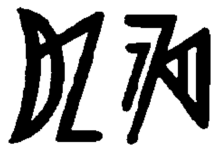Sani language
| Sani | |
|---|---|
| nɪ˨˩ do˨˩ | |
 Sani written in Yi script | |
| Native to | China |
| Ethnicity | Yi |
Native speakers | 100,000 (2007)[1] |
Language family | Sino-Tibetan
|
Writing system | Yi script |
| Language codes | |
| ISO 639-3 | ysn |
| Glottolog | sani1269 |
Sani (Chinese: 撒尼; pinyin: Sani) is one of the Loloish languages spoken by the Yi people of China. It is one of six Yi languages recognized by the Chinese government, under the name Southeastern Yi. Sani is spoken in Shilin, Luliang, Luxi, Shizong, Yiliang, Malong, Luquan, and Mile counties by about 120,000 speakers.[2]
The Sani [sa˨˩ni˨˩] call themselves [ni21]. Their language is distinct from the closely related Samei, whose speakers call themselves Sani [sa21 ni53].[1]
Another group known as the Sa 撒 (autonym: Sani 撒尼) lives in Qiubei County (Yunnan 1960).[3] Yunnan (1960) considers it to be similar to Sani of Shilin County. The ethnic population consisted of 1,443 as of 1960.
Innovations
Pelkey (2011:378) defines two innovations that Sani and Axi both share with each other.
- Exclusive devoicing of tone category 1 proto-voiced initials (even if there is voiced retention in tone category 2). These words include 'fly (v.)', 'wing', 'bridge', and 'liquor'.
- Dominant -e/-ɛ reflexes of *-ak rhymes.
References
- ^ a b Sani at Ethnologue (18th ed., 2015) (subscription required)
- ^ Wang Chengyou [王成有]. 2003. Yiyu Fangyan Bijiao Yanjiu [彝语方言比较研究]. Chengdu: Sichuan People's Press [四川民族出版社]. ISBN 7540927658
- ^ Yunnan minzu shibie zonghe diaocha zubian 云南民族识别综合调查组编 (1960).Yunnan minzu shibie zonghe diaocha baogao 云南民族识别综合调查报告. Kunming: Yunnan minzu shibie zonghe diaochazu 云南民族识别综合调查组.
- Pelkey, Jamin. 2011. Dialectology as Dialectic: Interpreting Phula Variation. Berlin: De Gruyter Mouton.
- Ma Xueliang 马学良. 1951. Sani Yiyu yanjiu 撒尼彝语研究. Beijing: Commercial Press 商务印书馆.
- v
- t
- e
| ARs / SARs | |
|---|---|
| Prefecture | |
| Counties/Banners | numerous |
| |||||||||||||||||||||||||||
| |||||||||||||||||||||||||||
Chinese
- Chinese Sign
- Northern (Beijing) Sign
- Southern (Shanghai) Sign
- Hong Kong SignHK/MC
- Tibetan SignXZ
- GX = Guangxi
- HK = Hong Kong
- MC = Macau
- NM = Inner Mongolia
- XJ = Xinjiang
- XZ = Tibet












